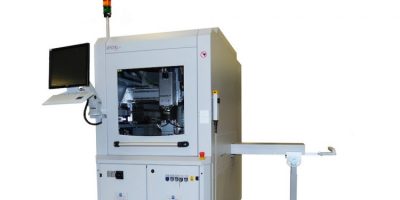IPTE adds frameless routing option in PCB de-panelling process
Frameless routing has been added as an option to the IPTE FlexRouter II to increase efficiency. The IPTE de-paneller FlexRouter II uses frameless routing, so that no PCB waste is left after milling. This technology increases ecological efficiency by reducing non-usable PCB waste, explains IPTE. To accommodate PCBs without a frame, IPTE developed a new transport solution so that PCBs without a frame can be de-panelled quickly with a stress free and precise process, using a milling spindle.
The FlexRouter II targets medium to high volume production lots featuring varied PCB versions. These are the demanding high-mix de-panelling tasks based on short machine set-up procedures. Despite the very small footprint – the machine width is only 500mm – board sizes up to 330 x 400mm can be processed. Four of the seven machine axes are integrated as precise linear drives.
In the FlexRouter II the PCB panel is fed in, securely clamped and its position precisely identified and adjusted by a measurement system. A programmable servo-gripper is used for clamping during the cutting operations, meaning that a panel-specific gripper is usually not needed. There are no additional gripper-tooling costs. The gripper mechanism features a Cartesian three-axes system assembled on a rotating axis. The milling spindle under the panel is also positioned by a Cartesian three-axes system and can be equipped with different spindle types. Gripper fingers are exchanged automatically to ensure the change-over from one product to another is quick and easy, notes IPTE.
After the milling spindle has cut a single PCB from the panel, the board is set aside while clamped by the gripper. A variety of PCB stacking options can be used, according to customer requirements to receive an optimum process flow. Options include dual and single tape conveyor feeder, tray module to a size of maximal 600 x 400mm, work-piece holder, linear shuttle or rotating table for the subsequent and individual customer procedures. There is also the option to measure the singulated PCB by automated optical inspection (AOI) technology.
Generating new routing programs is facilitated with a camera-based system or the integrated DXF-converting software which supports CAD data acquisition. The machine user interface is designed for the intuitive and easy execution of all necessary functions of the FlexRouter II, says IPTE. Special features are implemented as standard in the FlexRouter II, such as a provision for the usage of various sections of the milling head in order to reduce the costs for this consumable, the auto-mated exchange of milling tools and a detection function for their possible breakdown.




